Eliminating Energy
In my previous post Understanding Energy I explained the reasons that designers include energy systems in their games:
- Habituation
- Content Pacing
- Monetisation
- Strategic Choices
I also noted that energy systems aren’t particularly elegant systems – they rarely blend well with the setting of the game, and this disconnect makes them disliked by players. Removing or eliminating energy systems from mobile games is no easy task. There are some directions that bear consideration and further investigation though.
Pacing through quests
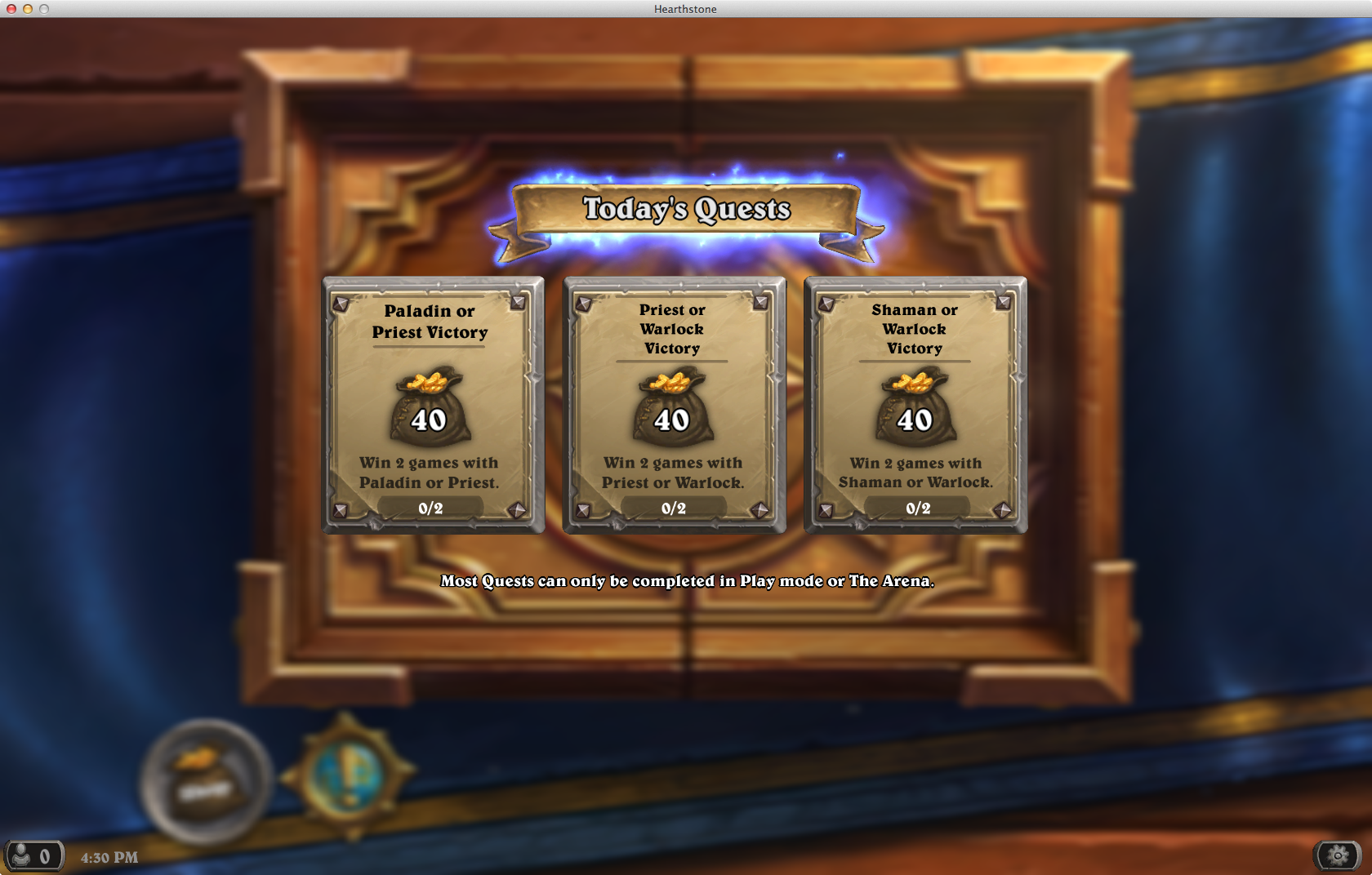
Energy systems pace players by limiting the amount that they can play. This clearly prevents players progressing too fast through a game’s content. However, it is possible to limit the rate of progression directly, whilst leaving play unlimited. The way to do this is to decouple the main source of rewards in the game from play, so that rewards can be limited independently of play time.
The best case of this is Hearthstone. Here the quest system is the main pacing mechanic, as it is the main way that players can earn in-game currency. Players get one new quest each day and each quest requires perhaps three to ten matches to complete. Once the player has exhausted their missions, they can continue playing for rank or pleasure, but their ability to earn coins is negligible and so the game economy is protected.
For most mobile games this route is likely to be the easiest and most satisfactory route to removing energy and timers.
Session length and synchronous PvP
Another way of pacing players is to increase the amount of play time required to progress. The pace that players can progress is then limited by the number of hours they can sink into the game. The big caveat to this is that it is much easier to do this on console / PC than on mobiles.
Mobile games are designed to fill the gaps in people’s days – when they are waiting for the bus, queuing for their coffee or avoiding work on the toilet. A mobile game needs to have a satisfying session possible in 1-3 minutes to fill these gaps. For a mobile game it is very difficult to give players a satisfying session in just a few minutes without bombarding them with rewards if they decide to play for a few hours – perhaps 50-60 sessions all in one go.
PC and console games have it easier as they are designed to be played in stretches of 2-3 hours at a time. A Hearthstone match lasts 5-15 minutes, whilst a League of Legends match lasts 30-45 minutes, so a few hours play is a handful of matches. This means that the base rate of progress can be extremely slow. These games get away with such slow progression because they rely heavily on synchronous PvP battles. The excitement of facing off against other people in real time compensates for slow progression in the meta game.
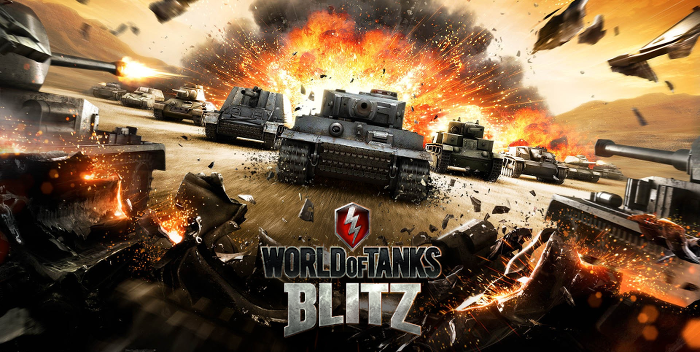
Mobile games typically have problems with synchronous PvP because people want to pick up and drop mobile games at any time, and there is little commitment to stick with match, which combined makes for a poor user experience. That said, World of Tanks Blitz has managed to be successful in spite of these challenges. Although the battles are typically only 4-6 minutes, the game still manages pace progression slow enough to avoid an energy system.
The problem that World of Tanks Blitz has is that whilst it covers off content pacing just fine, it monetizes very poorly compared to most other successful mobile games. Indeed seems unlikely World of Tanks Blitz would be successful without a PC product to support its brand awareness. 8 Ball Pool has also managed to be successful here with even shorter play sessions, but faces the same issue with revenue. Being the dominant digital version of a hugely popular real world game seems to be a major factor in 8 Ball Pool’s success.
Limited progression and asynchronous PvP
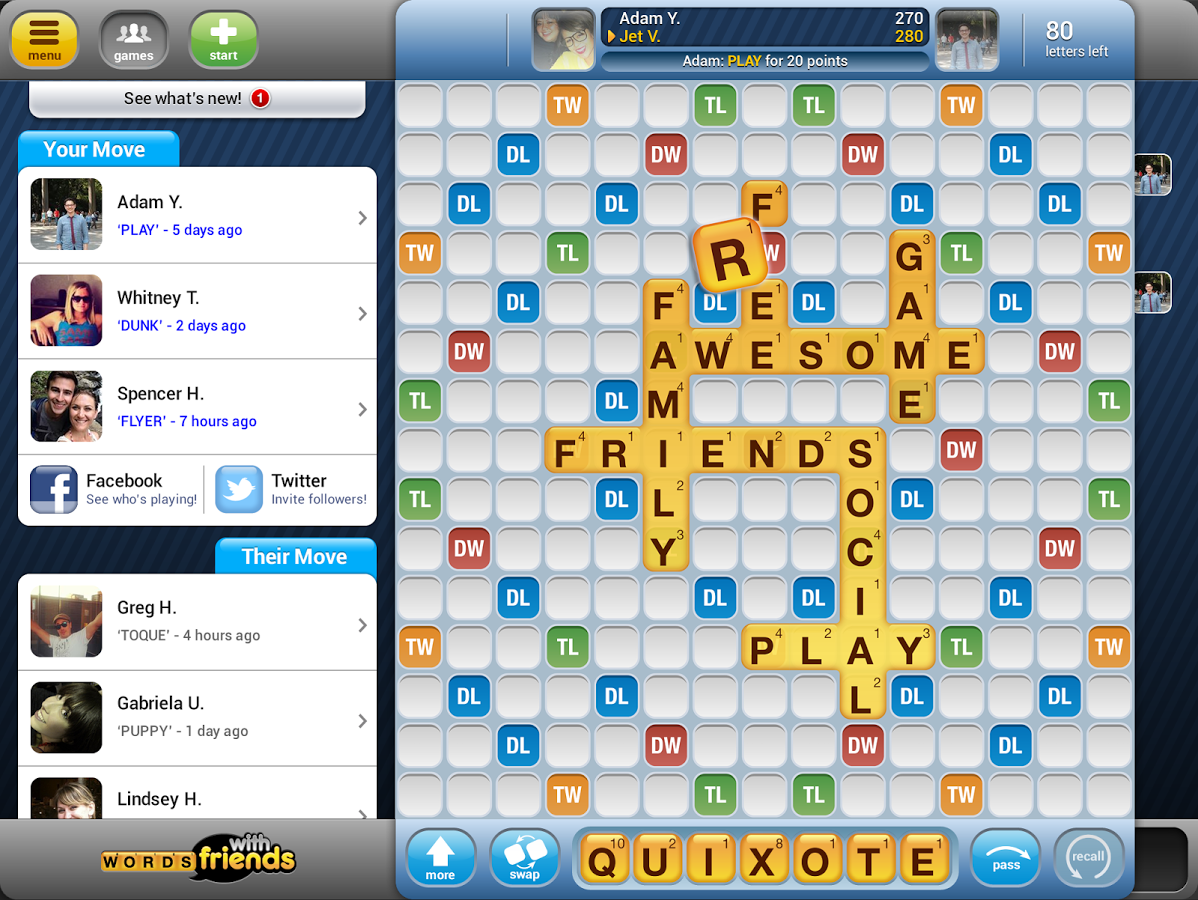
Another small set of mobile games have managed to be successful without energy systems by limiting the amount of progression available to players. Games such as Words with Friends and Draw Something offer players an asynchronous PvP experience that is incredibly viral, and where the costs of creating content are minimal.
As content is generated by other players, there is no need to limit play time. However, in order to keep the playing field fair and prevent the games becoming play to win, these games have very little to offer in terms of progression and hence to sell to players. Both Draw Something and Words with Friends rely heavily on in-game advertising to generate revenue as they have so little to sell themselves to players.
Framing
If eliminating energy altogether is not possible then framing it correctly to players can greatly improve the player experience. World of Warcraft experimented with their pacing system, primarily to habituate players into certain play patterns. Their initial mechanism halved the XP that players could earn after a certain point, encouraging them to end their session.
Players universally hated it. Blizzard responded by reframing the system, turning “normal” XP into “bonus” XP that still halved at exactly the same point, but now instead of dropping down to a penalized level, it just dropped something they called “normal” XP. Suddenly players loved the system; although the numbers were exactly the same players felt rewarded instead of punished.
In the same way, timers usually feel better than energy points. If it takes me a certain amount of time to build a building, travel somewhere or train troops then that fits with the narrative of the game and feels better than it costing energy, which appears to be (and is) an arbitrary cap on the amount I can play.
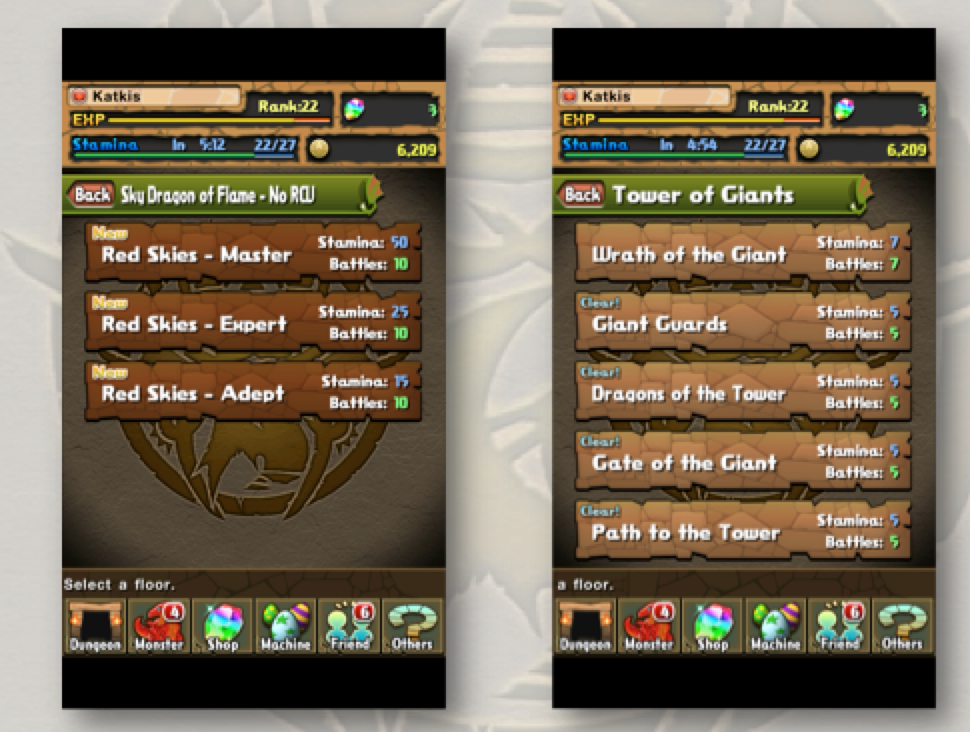
Another way to make energy feel better to players is to give players some control over it. Basically, make a game out of spending energy. In Brave Frontier and Puzzle & Dragons the amount of energy that each levels costs differs. Players have to figure out how best to spend their energy, and not leave a small amount left over and wasted.
In Boom Beach players only need to train troops if their troops die in combat. Players can therefore attack lots of different opponents in the same session, as long as they pick them carefully. The game is obviously balanced to players playing in this way, but they feel a lot smarter because of the control they have over the timers presented to them.
Conclusion TL;DR
Eliminating energy is not an easy design challenge for mobile games. Pacing player rewards is one obvious route that more games should investigate. Some games may be able to rely on PvP play and user generated content to limit the rate of progression, though monetizing these games is generally a challenge. For many games the best they will be able to do is to frame their energy systems in ways that make them more palatable to players.
Understanding Energy Systems
Energy seems to be hated by designers and players alike, so why does it endure as the hallmark of casual F2P games? The fact is that whilst it’s a crude mechanic, it’s also an efficient one, delivering several functions in one easily implementable feature.
This isn’t a defence of energy systems – I’ll follow up with a post on ways of replacing them – but without something fulfilling these roles then it’s unlikely you’ll make a very good game. I’ll talk about energy and timers fairly interchangeably here as they are both pacing systems that function remarkably similarly.
The four main reasons that mobile designers use energy systems are:
- Habituation
- Content pacing
- Monetization
- Strategic choices
Habituation
The primary reason that designers use energy systems is to encourage players to play as long and as frequently as they would like. The amount of energy gives an easy way to fix the length of the play session, whilst the energy refill rate determines the play frequency. Energy systems do this by providing the player with closure – the feeling that they have done everything they need to in a game, and that when they return there will be new, fun stuff to do.
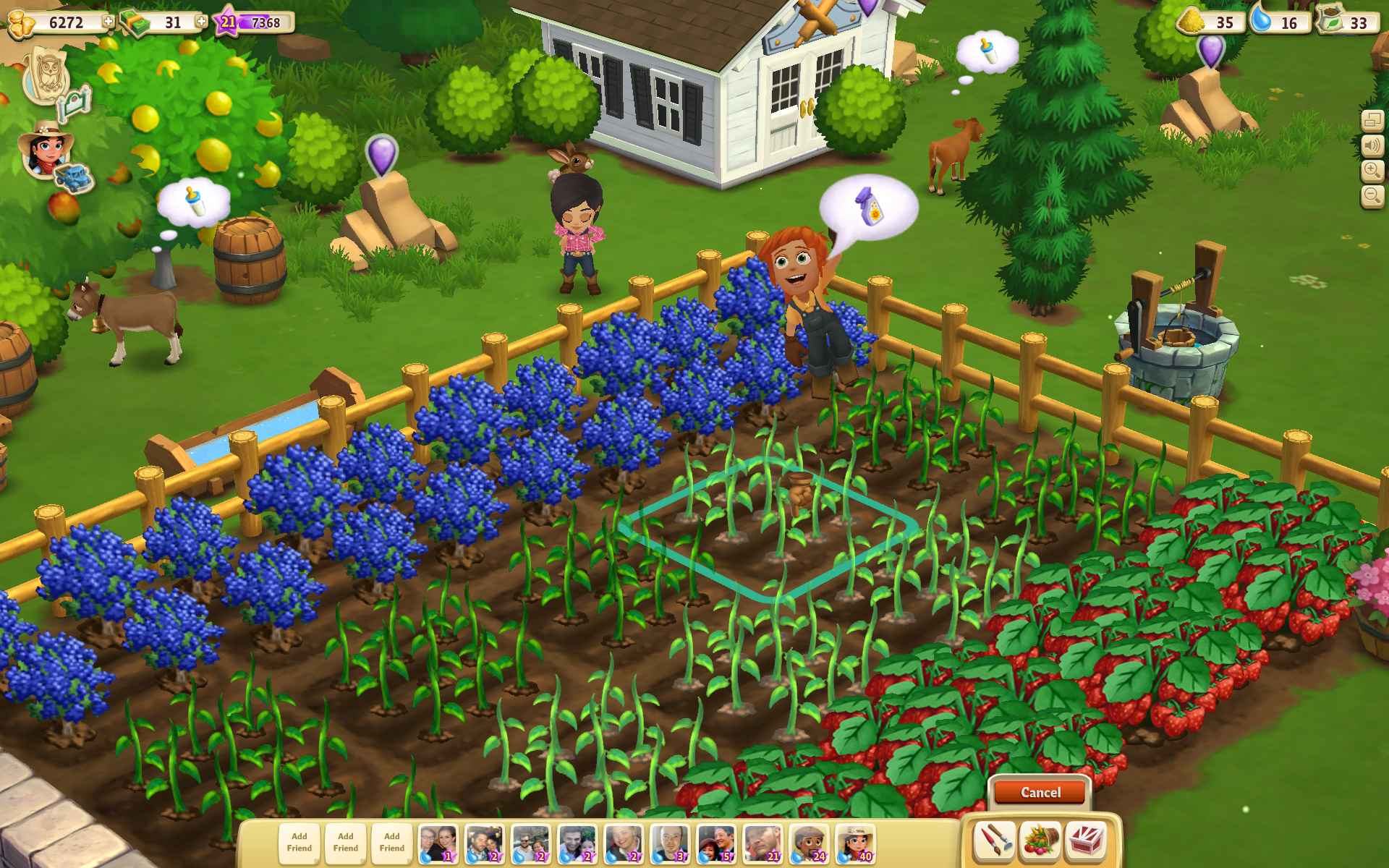
This is why crop and resource production timers work so well. Players coming back to the game harvest all the crops that have grown whilst they are away – a hugely positive experience. Then they can use the crops to complete deals, craft things and improve their farm. Finally they plant their crops so ready for their next session. As they leave the game there is nothing more for them to do in their farm, so it feels like a natural point to stop playing; but they also know that when they return they can get the satisfaction of harvesting their crops again.
Designers need to be able to control session length and frequency because it allows them to integrate their game into their players’ daily routine. Any activity that becomes part of your daily routine is likely to be something that you keep doing a lot longer than you otherwise might, and long term retention is highly correlated to lifetime value.
Think of the game as chocolate. If you had unlimited chocolate (and limited willpower) you might binge on it to the point you were sick of it. At this point you wouldn’t want to eat chocolate again for a while. Imagine if you got a small piece of chocolate every afternoon with your coffee break though. Now the chocolate enhances your coffee break, but at the same time, you never have enough in one go to get sick of it. Instead you look forward to the chocolate enhanced coffee break, and would miss it if it was taken away from you. As with chocolate, so goes gaming.
Content pacing
The second main reason that designers use energy systems is to pace their content, and to ensure that players consume content at roughly the same rate. Once players have run out of new content to experience, they usually have little interest in a game. It is vital therefore, to ensure that players are not consuming content faster than you can produce it.
Energy systems are crucial to minimising inequality in game economies; they ensure that players all consume content at roughly the same rate
PvP games often have an advantage here because their players effectively produce content for each other to consume. In Clash of Clans, each player’s layout of their base is unique and interesting for other players to attack. But Clash of Clans still needs to bring out new units, upgrade levels and features on a regular basis to keep their most engaged players.
Energy systems also help to reduce the “distribution of wealth” in games that exists between highly engaged and less engaged users. By capping the rate that the most engaged players can play, they cannot get too far ahead of the less engaged players. This is important for balancing, as a game should remain interesting for both types of players, and setting a progression rate that is interesting for the slowest players and yet doesn’t allow the fastest players to run out of content can otherwise be a challenge.
Monetization
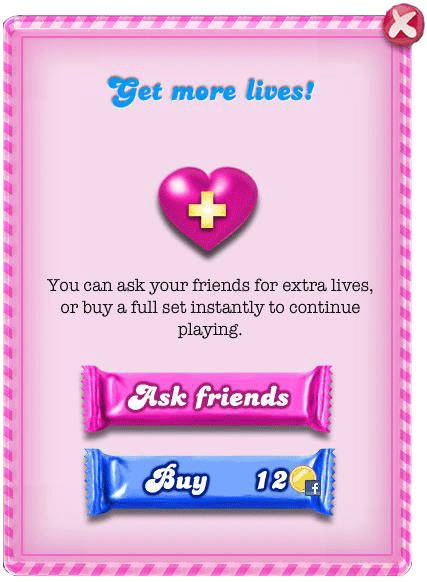
Making money is the third reason that designers use energy systems. In casual games energy might typically represent a third of bookings. This is not insignificant, but there are better ways to make money out of games, and monetization alone is a poor reason to go with an energy system. Energy doesn’t typically make for a very exciting or satisfying purchase, as it gives players something that they could get if they waited a bit longer. Most mobile designers realise this and despite the perception of energy systems as a cynical way to extort players, it is rare to see them if they are not needed for habituation and content pacing as well.
Strategic choices
In some games energy systems also provide the player with a strategic choice that they need to make. This comes from having a limited number of energy points to spend each session, and a greater number of possible actions. Players must decide what to spend their energy on, and because of this they usually need to set themselves a longer term goal that they are working towards over several sessions.
For example, in Clash of Clans, because I can only upgrade 2 or 3 buildings at a time, and each one might take anywhere from a few minutes to a few days, I need to work out what I prioritise. Do I upgrade my resource generating buildings first to facilitate further upgrades, my storage space allowing me to raid more, or my defensive buildings to protect what I’ve got? In prioritising my current session, I also create a mid term plan for my future sessions as well, which builds off this. In games where the energy system doesn’t allow the player any real choice in what they do, the system typically feels even more arbitrary and restrictive.
Conclusion
The reason that F2P designers use energy systems is not because they hate players, it’s because energy systems are efficient mechanics to encourage specific play patterns, pace content, monetize a game and provide a player with strategic choices. Designers should be wary of releasing any game without features that cover all these bases one way or another.
Deconstructing Hearthstone by Blizzard
Blizzard’s Hearthstone has defined collectable card games (CCGs) on mobile over the past year, and with the recent launch of the versions for smart phones on both iOS and Android the mobile revenues have rocketed roughly sevenfold.
Hearthstone is an interesting game to look at, because it breaks so many of the conventions of mobile F2P:
- It has no energy system
- It sells only permanent items
- It is highly skill based
- It is mainly synchronous PvP
As such it appeals to a lot of self designated “gamers” that find other mobile games somehow below them. This run down of the game will take apart the main features and discuss how they create and great game, and whether there are larger implications for the mobile F2P industry.
Core Loop
The core loop in Hearthstone is incredibly simple:
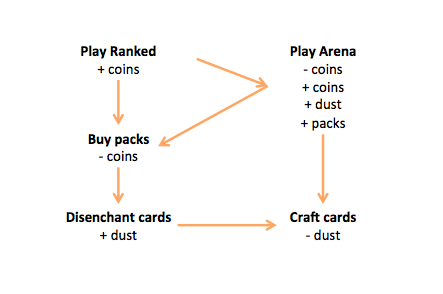
There are two main play modes: Ranked and Arena.
Ranked can be considered the basic game mode, where players play against each other synchronously to climb a monthly ladder. Players use decks that they have constructed from their permanent card collections. It is free to play, and players earn coins for winning matches and completing quests that appear daily.
Arena can be considered a secondary play mode, but is hugely important to and complements Ranked play. Here players also play synchronously with each other, but they must pay an entry fee – either coins or real money. Players make a deck as they enter the arena, choosing one of three cards at a time until they have a full deck. The rewards depend on a player’s performance, but can be generous compared to the entry cost.
The balance of the two modes is important, because it provides both payers and non payers, as well as players of different skills something to do. Earlier on, players may find Ranked play easier as they learn to put together decks that rely on specific combos. Later on they may find Arena more fun as there is the challenge of putting together a deck on the fly, and all players have the same chance of getting legendary cards.
Pacing

Quests act as the pacing system in Hearthstone, but it is so well framed that many players don’t see it for is. Rather than restricting the number of matches that players can play in a certain time, quests limit the amount of coins that a player can earn. Players get one new quest each day, and are limited to having three in total at any one time. Players can earn small amounts of coins for winning matches in Ranked play (10 coins every 3 wins), but this is small both compared to the time it would take to play these matches (perhaps 30 minutes or more on average), as well as the coins earned from quests (40-100 per quest).
As players earn most of their coins from quests, and not from playing matches, Hearthstone has no need to limit the amount of times a player can play. Players can (and do) sink hours into climbing the rankings without breaking the economy, as after the first few games their in game earnings are virtually nil. This is such a simple yet effective feature I am amazed that more F2P games have not copied it – energy systems are by far the most hated, yet standard F2P systems.
Single currency, single resource
I count coins as the single currency in Hearthstone and dust as the single resource. Hearthstone does not have a soft currency for everyone and a hard currency for payers. It follows therefore that it does not have items that can only be bought for hard currency. Purchasable things in the game can either be bought for either coins or real money. Dust is reserved exclusively for crafting specific cards.
The fact that as a non payer you can get anything in the game, and you can earn coins at a reasonable rate, helps create an environment that seems fair and inviting for both payers and non payers alike. Whilst the temptation to drop real money on a bunch of packs is constant, it never feels like someone has beaten you just because they’ve spent money on the game.
Permanent purchases

The nature of card rarity in Hearthstone also supports the feeling of fairness. Cards have one of four rarities: common, rare, epic and legendary. However, in contrast to many of the other mobile CCGs, cards cannot be upgraded or fused. This means that buying cards always results in a permanent addition to your collection, either directly or through the crafting system.
As with all CCGs there needs to be some method of dealing with duplicate cards, to maintain the randomness of pack opening. Hearthstone only allows players to have two of each card (one of legendaries) in their deck. Duplicates beyond this can be disenchanted for Hearthstone’s main resource: dust, which in turn can be used to craft any card in Hearthstone. The conversion rate is obviously not great – cards give only 25% of their cost to craft when they are disenchanted, and making progressively rarer cards gets ever more expensive. You need to disenchant 320 common cards to craft a single legendary. But the system does mean that even if players only get duplicates through randomly opening packs they can work towards specific cards that they want to create particular decks.
The fact that purchases result in permanent items that cannot be taken away from the player makes them all the more attractive. Players know that if they get a legendary card they will always have it, and its power will stay constant. Players can still spend huge amounts of money on the game, as there are so many cards to collect and the chance of getting a legendary is so low. Various Reddit posts put the cost of a Legendary at around $12-24, so with 67 legendary cards currently players could easily spend over $1,000 getting all of those alone. The cost of the epics and rare cards would be on top of that, and players can pay 4x for cards with a gold back – a purely cosmetic change.
Buying Experience
[youtube https://www.youtube.com/watch?v=_N0p4YSXn4Q]
The permanence of purchases together with the overall polish in the game creates an incredibly positive buying experience. You would expect nothing less from Blizzard of course, but the pack opening sequence is spectacular, especially when compared to the drab experience in many mobile F2P games to skip a timer or add more resources. Buying something feels great, a detail that is all too often overlooked.
Skilled play vs. Pay to Win
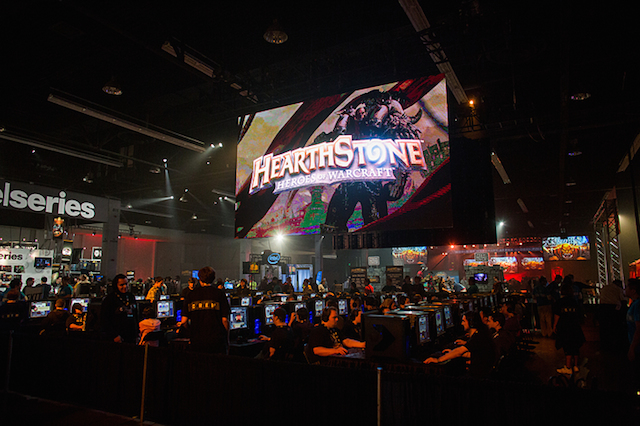
Most mobile F2P games steer clear of including too much skill. Skill makes games more difficult to balance, as players will have a varied experience of the same content. Furthermore, with highly skilled games it is difficult to give players a continuous sense of progression, as their skill level will typically plateau after an initial learning period. As most mobile F2P games are selling progress, they need to maintain the sense of progression that grind based games give, as ensure that players have broadly the same experience by leveling the playing field with luck.
In contrast, Hearthstone has a high degree of skill – the game has an impressive number of tournaments and events, and Blizzard host a World Championship at BlizzCon that had a prize pool of $250k last year. Youtube and Twitch are awash with Hearthstone matches and the top players are starting to make their fame and fortune from the game. This is clearly a far cry from games like Clash of Clans or Game of War, where success largely depends on the amount of time (and money) players can grind into the game.
That said, in Ranked play, working your way up gets more difficult the higher you go not only because you meet more skilled opponents. Any player will tell you that you need to both have the right cards to put together in a deck to create the right combos, as well as the ability to change your deck as you go. This flexibility is vital as the meta game changes as you move through the ranks. At a given time, rush decks might be unstoppable at ranks 20-15, but easy prey above rank 10.
Always having the right epic and legendary cards to finish off your deck becomes essential, but you rarely need very many of them to create a good deck. The pressure to spend is in having the necessary breadth of cards, rather than a deck construct solely of very rare cards. This creates a dynamic where players do need to spend to play at the highest levels, just as League of Legend players need to practice with all the different Heroes rather than just the ones that are freely available that week. At the same time each individual card is balanced for its mana cost and players who have spent a lot of money to acquire a lot of different cards might be beaten by a player who has spent very little, but happens to have the right cards for that particular battle. Players must spend to progress in general, but matches don’t feel pay to win.
Synchronous PvP
Hearthstone is one of the only successful mobile games to centre on its synchronous PvP experience. Vainglory and others have tried to take this challenge on, but no one else has succeeded except another game backed by a massive desktop IP: World of Tanks Blitz. Hearthstone was in beta on PC 9 months before coming to iPad, and had half a million downloads before it even hit the App Store. This period was essential to give them the critical mass needed to match players with each other at an appropriate level. Without it players would either be facing long wait times every match they played, or getting matched against players of very different skill – either case is a potentially game breaking experience.
Blizzard’s ability to drum up this level of interest in a new game is a testament to their expertise at launching new synchronous PvP games, but absolutely not a reference that other developers can hope to emulate. Without Blizzard’s existing World of Warcraft IP, installed fanbase, community management efforts and PR, the game would have faced a much harder prospect of building the community necessary for critical mass. I do not believe that we will see a synchronous PvP based game successful on mobile without a PC version any time soon.
Conclusion
The success of Hearthstone, combined with how different it is from many other mobile F2P games makes you expect it would have a huge impact on the prevailed design trends in the industry. The pacing system in particular seems superior to the energy systems that are still prevalent in many games. However, the fact that Hearthstone was launched PC first on the back of the huge World of Warcraft brand has allowed a number of other differences that the vast majority of mobile F2P developers cannot hope to emulate.
Big Fish, Small Pond: Surviving in a Maturing Market
Last week I attend Quo Vadis in Berlin and gave a talk on how to survive in a maturing mobile market. The slides are below.
[slideshare id=47449929&doc=2015-04-23-quovadisedbiden-150427033201-conversion-gate02]
My main take away was that companies need to set themselves smart constraints within which to be creative.
The four ideas I gave for setting yourself smart constraints were:
1. Know your strengths
Whatever your strengths are, be that an existing audience, particular technical expertise, or genre knowledge, you have to build on that. The market is tough enough without you giving yourself the best chance.
2. Find your pond
Incumbent games have too much market presence and content and too many systems and players to go head to head with. Define your market as a niche that is small enough for you to dominate (though big enough to pay the bills).
3. Manage the Risk
All game production is risk management – no one knows for sure if a game will be a success or not before it launches. Make sure that you manage the risk in production as well as possible. Do a risk assessment as you start out a project to get an objective feel for the number and scale of risks involved, and an idea of when they can be addressed (sooner is better!). This will also help you tackle the biggest risks first wherever possible.
4. Stick to the plan
It’s very easy half way through production, when things aren’t going well, to convince yourself that you just need a couple more months to fix things. Set yourself some fixed targets at the start of the project that trigger a full scale review of the project if they are missed. That way you will waste the least amount of time on projects that are doomed.
Harnessing the Psychology of Gifting
I feel like gifting has a bad name in games. Like the term “social” it has been ascribed to Facebook games that often implement interesting features in unexciting ways. Understand the psychology behind gifting in general – the phenomenon that is ubiquitous to all human culture and almost every human interaction – and I think things get a little more interesting, as well as suggest features that would work better than the average Facebook game.
Gifting and exchange are a component of almost every social interaction. This is even apparent in the way you greet your colleagues in the morning. If you see someone for the first time in the day that you work with then you are obliged say hello. They, in turn, are obliged to acknowledge your greeting and respond. If you barely know each other the exchange is short and perfunctory: “hey”, “hey”. If you know each other better, it might spawn a longer conversation or at the very least require more conviction.
Even this mundane situation exhibits what anthropologists know as the three obligations of gifting:
- The obligation to give (to say hello in the first place)
- The obligation to receive (to acknowledge that greeting)
- The obligation to reciprocate (to say hello back)
In such a minor social interaction the exchange is fast and low value. But even so, to omit any of these steps would be rude. If a colleague continually ignored your greetings, then you would think less of them. Let’s examine the three obligations in a little more detail.
Giving
Giving gifts or initiating exchange is an action that is required in certain situations. In western culture we buy each other gifts at Christmas and on birthdays, and we take a bottle of wine or contribution to the meal for a dinner party. Failure to give at these times can be a serious faux pas depending on how well we know the other person.
Receiving
When someone offers you a gift you are obliged to accept it. To refuse a gift is to be unfriendly, if not rude. To turn down an invite to dinner for no good reason would be frowned upon, to refuse a Christmas present from a family member almost unheard of.
Reciprocating
There is an obligation to repay all gifts. In some cases this is more immediate and calculated than in others. If you give a friend a birthday present then you might expect one back from them, and Christmas gifts are often a minefield of social obligations to find gifts that correctly reflect the value previously received and current state of the relationship between two people. The tighter the relationship between two people the more that the value and timing of gifts becomes varied – both parties expect that everything will work out in the long run.
Indeed to repay a gift too quickly or exactly and remove the implied social debt is as unfriendly as not returning it. If your friends help you move house you deliberately repay them with something where the value is hard to calculate, such as cooking them a meal, rather than paying them cash. Relationships typically start with small one-off gifts of time or effort and gradually extend into a continuing cycle of reciprocity. In extremis, almost all major religions advocate giving to charity for benefits in the afterlife or from the universe in general. We have an innate belief in karma of one kind or another that is hard to shake.
Now we’ve gone over the theory, let’s look at gifting in three games, in particular, to see how it’s applied:
1. Pearl’s Peril is a Facebook and mobile hidden object game with fairly typical energy and item gifting. (Disclosure: I’m currently game designer on this game)
2. Clash of Clans gives you the ability to donate troops to your clan members when they request them.
3. Animal Crossing has a sophisticated gifting system with both other players and NPCs.
Pearl’s Peril
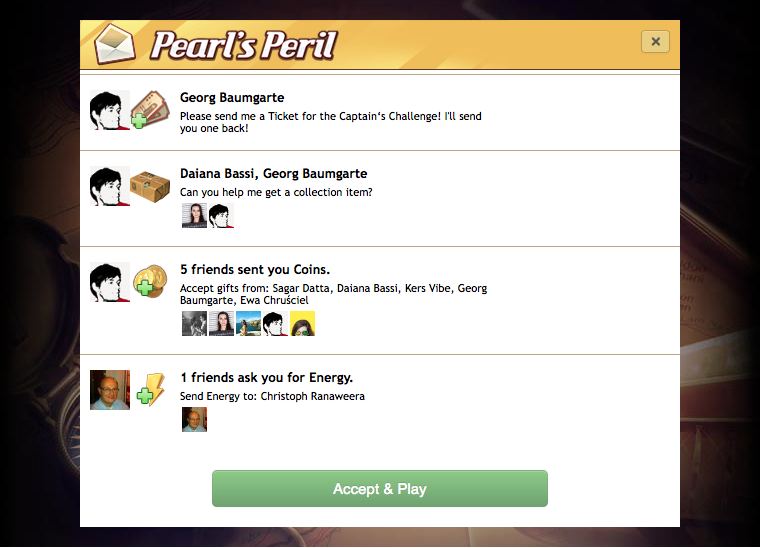
As in many Facebook games Pearl’s Peril allows you to send energy, soft currency and low value collection items to your friends. In each case it doesn’t cost you anything to send the gift – the gift is created out of thin air during the gifting process, and the process itself is incredibly streamlined, allowing gifts to be sent from multiple points in the UI and delivered to the recipient’s inbox where they are accepted in a click that is barely noticed coming into the game.
The result is a social feature that is rather like greeting a colleague each morning. In interviews players describe it as a habit that they fall into – almost like a pleasantry of saying hello. It’s a valuable feature because they value the energy, but the gifting act itself is less so. Players do not feel obliged to log in just to send gifts to their friends and maintain the cycle of exchange.
Clash of Clans

In Clash of Clans you can donate troops to your clan members. You have to spend resources to train these troops yourself, and you could use them in your own attacks if you didn’t give them away. In many cases the only value that gifting affords you is allowing you to take a few extra troops into battle: those troops stored in your clan castle and donated to you. It does however give lower level players the opportunity to play with much more powerful troops given by other members of their clan, foreshadowing units they will have in the future if they stick with the game. It also requires some degree of coordination so that you get troops that support your style of play, which stimulates discussion in the chat.
The system is much more powerful than energy gifting in Pearl’s Peril. Clan members can see how many troops they have donated vs. received and compared to other clan members helping them keep track of a number of different relationships and making sure that gifting doesn’t get too imbalanced. Donating troops was really the only thing that clans allowed you to do originally, but the system has been further reinforced by clan wars, which provide an obvious occasion to donate troops.
Players that fail to keep up their side of the bargain – not giving as many troops as they receive, or not giving troops when they should – face being kicked from their clan to make room for more committed players. Higher ranking clans often state these obligations and enforce them rigorously. At GDC this year, Supercell stated that the 2 year retention for Clash of Clans is 10%, and I believe that the gifting economy that they have created in the game is a key component driving this.
Animal Crossing
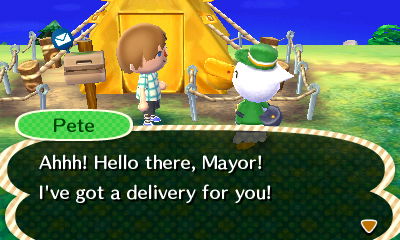
Anyone that has played Animal Crossing will tell you it is a magical game that creates quite a unique atmosphere. Dropped off in a village of anthropomorphic animals you can gather fruit, fossils and flowers, catch butterflies and fish, design your own clothes and furniture and develop relationships with the NPCs and other players in your village. There is no real goal, but players typically spend their time collecting things and exploring the world, which changes season by season and through a day / night cycle.
It is perhaps the game that shows the best giving mechanics that I have observed. The calendar gives you a natural context to give things due to birthdays, other occasions or simply because you found something you know they want or don’t have space for yourself. NPCs also prompt you to gift on a regular basis, by asking you for things, letting it known they are looking for particular items, and occasionally sending you gifts themselves.
Most of the activities in the game drop items on a semi random basis, with some items rarer than others, but the selection constrained by the time and place that you are collecting. This makes gifts unique items, with each one requiring time and effort to find in the game world. In contrast to the commoditised resources that are given in Pearl’s Peril, you know each gift is special.
Indeed even sending the gift requires effort as you need to find the recipient in the game world or visit the post office to send it to them. Even if players do have multiple items that they want to give, each one needs to be given individually, rather than sent off as a bulk action. Similar to sending someone a hand written note over an email, it enhances the sense that the donor really cared about giving something to you.
The result is a powerful system with real emotional weight behind each gift. Gifting is one of the key systems that runs throughout the game and gives it such a unique and magical feel. The series consistently gets superb ratings from critics and is listed as one of the best selling games ever with c.27m copies sold across 4 titles. However the real demonstration of how effective this gifting system is comes from anecdotes like this one, about a mother with multiple sclerosis’s gifts to her son. It’s impossible to imagine either Clash of Clans or Pearl’s Peril creating this kind of story.
Conclusion
Gifting and exchange are ubiquitous human behaviours found in all cultures and a huge variety of situations. Gifting consists of three obligations:
- To give in certain situations
- To receive gifts offered
- To reciprocate gifts received
Increasing the value of gifts increases the emotional engagement and social obligations that players experience. Increasing the power of gifting can be done by:
- Making gifts unique rather than commoditized
- Making gifts require more investment from the giver
- Making the giving process itself require some effort
- Prompting players to give in clear situations
Great gifting systems support strong long-term retention, player satisfaction and by extension commercial success.
Content Hunger: How to avoid the content mill in gaming
Games are content, and so the economics of games are largely the economics of content. Content is what players pay for, and content is what takes time and money to build, with both the quality and amount of content increasing production costs. I’ve been playing a lot of Dragon Age: Inquisition recently, and having a great time. I’ve already sunk just over 20 hours into it, and if friends and reviews are to be believed, I have at least another 30 to go before I finish the main storyline.

Dragon Age Inquisition has a huge amount of high quality content to explore
The world you can explore is vast, filled with scripted missions, side quests, wild beasts, roaming bandits and hidden secrets. Romping across the landscape from rocky deserts to dank marshes I am both awestruck at the variety and volume of content in the game, and slightly sickened by it. Sickened, because now I work in the industry I know how much time will have been invested into producing everything I see, and how countless days must have been put into dark corridors, rock formations and other mundane details that give the world authenticity, but will be largely forgotten and ignored by players.
Mobile is some way behind the production values of consoles. Partly the hardware isn’t as good yet, and so cannot support such high end graphics. Partly developers have not needed to deliver such high quality games to win customers. But mobile is rapidly catching up, and whilst the quality of content may not be as high, the amount of content needed is already probably larger. The F2P business model dominates mobile, and success here is highly dependent on retaining your players for months or even years. Having something for players to do a year after they start playing your game is no mean feat. Wooga’s hidden object game Pearl’s Peril has 90 weeks of content – something that few if any console games can match, and as a result of this the retention in the game is phenomenal.
Content is a key competitive angle
It’s clear on both console and mobile that the amount of content you can deliver, and its quality are key factors for success. It’s hard to imagine an RPG without the amount and quality of content that Skyrim or Dragon Age has being a success. For a competitive HOG you need to deliver a similar amount of content as in Pearl’s Peril – something that only one or two developers apart from Wooga can hope to do. One of the reasons that World of Warcraft has become so entrenched is the amount of content that it has built up over the past decade is now almost impossible for other MMOs to replicate.
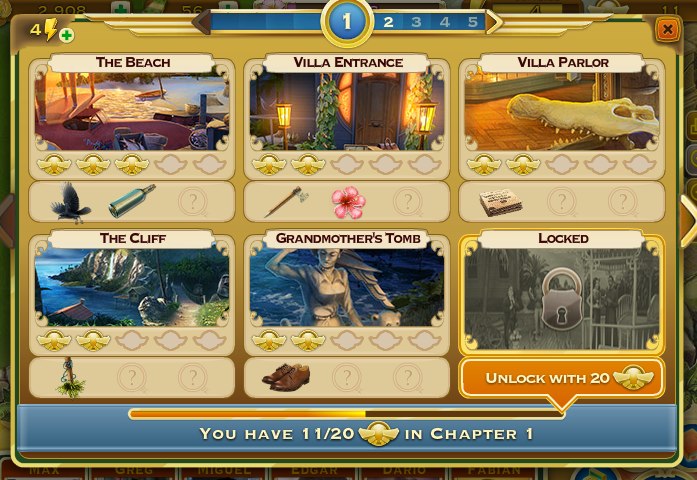
Pearl’s Peril has 90 weeks of content, each with 5 hidden object scenes and a point-and-click adventure scene
For many games the number of man-hours that have been put into content determines the production quality and amount, together with the efficiency that this time is converted into content, given the tools utilized. The older a genre is, the higher the production values are – by pushing the content bar ever higher, developers shut out competition and establish themselves in franchises for the long term. With each game developers up the stakes, both because they can due to improving tools and existing assets to start from, and because they must to continue attracting players.
Maximizing content
To be successful developers must therefore invest in their tools and production pipeline to match the incumbents in the genre they are going head-to-head with. Failure to do this sort of preparation can only result in failure. Indies and smaller developers that cannot match the content output of bigger companies must innovate on the gameplay mechanics more to succeed. By innovating they can produce a new experience that players will not directly compare with established games. No one compares Realm of the Mad God to World of Warcraft, or Faster than Light to Mass Effect. There are also a number of techniques that can be used to stretch content for as long as possible, and all developers, regardless of their content output are wise to use as many of these as possible.
Randomness: Games with randomness are far more playable than those without some element of randomness. In Candy Crush Saga, levels are different each time they are played due to the random way that gems drop into the board. Players replay levels effectively waiting for the right combination of gems to drop. Imagine the game without this randomness and each level has a solution that can be found by trial and error relatively quickly, and the levels become boring.
Alternative choices: Allowing players to customize their play experience in different ways allows them to go back and replay the same content to explore how their decisions influenced the game. Whilst this requires some additional content that not all players may see, it allows die hard fans to play through most of the same content several times with minor variations. A good example here is how Telltale games allow you to replay episodes making different decisions each time. These decisions allow you see how the other characters react and the story pans out. In Dishonored the skills you upgrade give you different ways to complete each level, and the amount of violence that you employ throughout the game affects the way the story pans out to give replayability significant appeal.
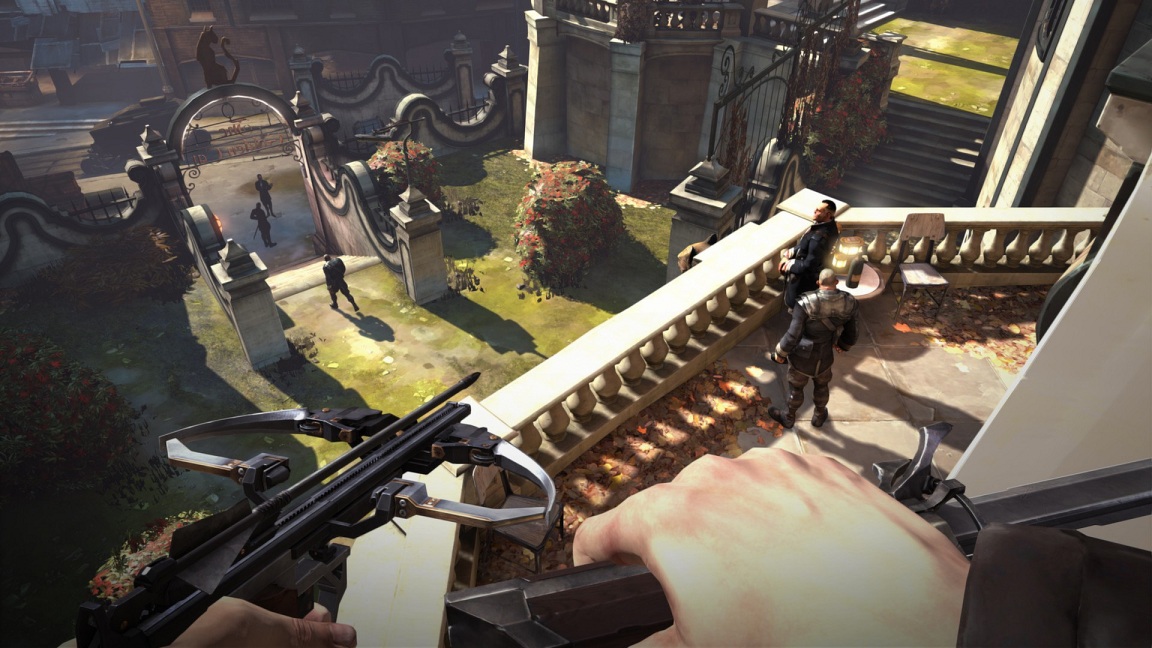
The way you play Dishonored affects how characters interact with you, the overall ending and even the weather in levels.
Events: Most successful mobile games run timed events of some form. Often the mechanics of the event are very similar, but the appearance of exclusive content that is only available for a limited period engages players extremely well. For the chance of getting a new unit, building or item players will happily grind through a lot of content that they have already seen before, and the most active players will often only be playing for the events schedule, having already exhausted the other content in the game.
Difficulty levels: In games where the difficulty of levels can be increased, then replaying the same content is fun because it requires players to master a higher skill threshold than before to complete. Changes in difficulty can often be made with config changes that are cheap to implement, and the players will still enjoy the content. Guitar Hero or Rock Band use this mechanic to allow you to replay the same tracks again and again at a level that is always challenging.
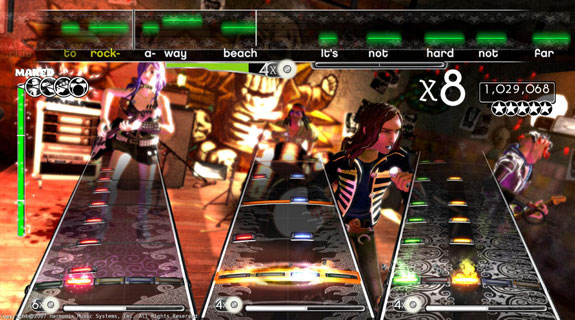
Rock Band lets you play through the same songs at several different difficulty levels
User Generated Content: In Clash of Clans, players spend most of their time attacking the bases of other players. As the layout of each base is set by the defending player then an incredible amount of variation is generated by the players. All Supercell needed to do was to give players the tools reason to vary their base layout and the players take care of the rest. Different bases require different tactics to attack and so even though additional buildings and units are released only very slowly, players stay engaged in the game.
Conclusion
In any genre, games compete on the amount of content offered and its quality, both of which drive up the cost of production. It is important to recognize the demands of producing this content before starting production and only choose genres where you can compete. Having chosen a genre it is vital that developers build the tools and pipeline to deliver the required content, as well stretch the playtime from their content however possible.
After the Gold Rush: Competing in today’s App Store
It’s hard to believe that the App Store is only six and a half years old – it was launched in July 2008 with just 800 apps. Now there are 800 apps downloaded every second – 2 billion a month – and the number of apps available has grown more than 1,000 fold to 850,000.
Games dominate this marketplace, with more than twice the number of apps as the next biggest category, and well over 10,000 new ones being added each month. The barriers to entry remain low – you can code and release a simple game on your own – but the barriers to success continue to get higher. This is typical of all markets as they mature, but it is striking just how fast this has happened in mobile, and developers of all sizes are finding the competition fierce. Beyond the sheer quantity of games available, there are three clear indicators of this development.
Top Grossing
The top grossing charts are largely static. Candy Crush Saga and Clash of Clans have been in the top 3 games for over 2 years now. These games appear to have locked down their respective genres in the way that Call of Duty or World of Warcraft has on other platforms. Many of the other games in top 10 are similarly long lived, and just two developers: Supercell and King consistently account for at least half of the top 10. Games that do manage to break into the upper reaches of the charts are notable because they are so rare now, and often supported by very strong brands, such as Kim Kardashian.
User Acquisition
SuperData estimated that the cost of acquiring a user increased 37% between Jan 2013 and Jan 2014. Machine Zone’s recent $40m advertising campaign for Game of War illustrated just how much money the top companies can throw at marketing. SuperData also reports that CPI now stands at an average of $2.78 for mobile games, whilst average revenue per user is just $1.96 – not a good ratio for developers.
Production Values
Super Evil Megacorp spent two and a half years developing Vainglory, and it showed – the graphics looked closer to AAA standard than what we would normally expect from a mobile game. Smaller developers can pull off great looking games such as Monument Valley or Badlands, but only when they choose very stylized appearances that facilitate lower costs of production. Even the UI transitions in Hearthstone demonstrate a level of polish that few established studios, let along Indies could hope to pull off.
So where does this leave us? How to we compete in a market that has become this tough? It’s a question that we ask ourselves a lot at Wooga, and even with our current successes (Diamond Dash, Pearl’s Peril and Jelly Splash) something that we are still working out.
How to find success?
Looking at the charts it is clear that cloning games does not lead to success – the only game with similar mechanics to Clash of Clans is Boom Beach, also by Supercell. Replicates of Candy Crush Saga have performed similarly poorly. It is for this reason that we do not clone games at Wooga, and never have. It’s also creatively unsatisfying and for a combination of these reasons many people advocate the opposite end of the spectrum: radical innovation in the hope of striking it lucky.
This was my approach on my last game too. Whilst Wooga has a history of casual, single player games, I set out to make an action strategy game. I loved the genre myself, and felt there must be an audience who were likewise unsatisfied by the current offerings on the App Store. I felt that given the talent at Wooga, our understanding of game design and the amount of user testing we used in the creative process we could make a success in any genre. But in hindsight this approach seems just as misguided as cloning games, as I had failed to recognize the current state of the market and the value of building on existing company expertise, tools and audiences.
Games are complicated systems, especially action strategy games designed to give years of play. We had a good prototype and the gameplay was novel and fun. But the more we worked on the details the more problems we threw up. Exactly because the gameplay was novel, we needed novel solutions to these problems – we could get inspiration from other games, but no one had solved these exact problems before. The team did a great job of working through these, but it took a huge amount of time and emotional effort to be continually rebuilding large sections of the game.
Risk is inevitable
Furthermore, as we worked through design issues, we realized that we were left with a number of risks that we could not remove before launch. By staying true to the vision of the game we had ended up with intense synchronous PvP gameplay that only Hearthstone and World of Tanks came close to. These are successful games, but it seems largely because of their existing PC audience. We also started hearing horror stories about the CPIs for the mid core audience, several times higher than the best LTV any of our existing games had. In combination we were not sure if the audience we were targeting existed, and if it did whether we could profitably reach them.
Despite the team’s enthusiasm for the game I could see that this was becoming a passion project for us rather than a legitimate chance at creating a commercial hit, and unfortunately for those of us that make games professionally, commercial realities cannot be ignored. Eventually I decided it was time to stop burning time and money and start on something afresh with greater potential. I realized that we had been arrogant enough to assume we could build something as good or better than what was already out there, despite having none of the tools, none of the design knowledge, and no audience compared to developers that were already making these sorts of games.
I remembered that Clash of Clans was an iteration on Backyard Monsters and Candy Crush Saga a refinement of Bejewelled. But even before their big successes, Supercell had experienced teams working on Hay Day and Clash of Clans, and King had its casual gaming portal and picked games out of that to develop for Facebook and then mobile. In each case the companies had existing assets that they built on, as well as refining mechanics from other games.
What to do with an existing audience?
A company with the size and track record of Wooga has plenty of assets to build on. We have an existing audience, established IPs, game design experience earned through hundreds of user tests and millions of players on our live games, the know how to set up extensive content pipelines and so on. We hadn’t recognized their value before though, and instead choose to innovate across the board. Our core gameplay was different, our elder game novel, we were attacking a more core audience we knew only as players ourselves. The only asset of Wooga that we really used was building on technical expertise from previous games. In our post mortem we realized this was also the one area that was free from major problems over the course of the project.
Let me be clear though, that when I talk of innovation, I am not talking solely about design. I am talking about all aspects of production from the audience and genre you choose to the technical setup you have as well. Design can be innovative and successful, but innovative designs are best supported when you build on existing assets elsewhere. Hearthstone is a great example of this: the team built on a vast wealth of assets that Blizzard had to make the game a success. There was the experience of the design team, the strength of the Warcraft brand and Blizzard’s ability to recruit half a million fans whilst the game was still in beta. The gameplay was fresh, the genre basically non existent on the App Store, but even from the outset the risks that the team faced were greatly reduced by building on Blizzard’s strengths.
I also believe that this is the case whether you are a mid sized developer like Wooga with 280 employees, or an indie developer with a fraction of that scale. The key is to recognize the particular skills and assets that you have, and the niches where you can best apply these. Smaller companies may need to choose small niches to succeed, but they also need smaller successes to cover their costs. As a smaller company you can serve niches that aren’t big enough to warrant the attention of bigger players. As you serve that niche you should aim to build up tools, marketing channels such as email lists and other assets that aid your future work and thereby grow your business.
Learning from my recent experience, for my next project I will work on something that builds on a far greater number of Wooga’s assets. This is the best way for me to maximize my chances of seeing my game launched and successful – a goal that I am sure many developers can sympathize with. This might sound like a dispassionate approach to making games, but I don’t feel that it needs to be. Like most people in the industry, I work in games because I love games. Building on the assets that Wooga already has may seem constraining given the wonderful variety of games that exist. But it is an additional constraint and not the definition of an entire project, and as the saying goes, creativity loves constraints.
This article was originally published on Gamasutra
Beyond Fun: Real Drama and narrative gameplay
We don’t tend to typically think about games as emotional experiences, and perhaps because of this, the most interesting talks I saw at GDC 2013 were about games that had made people cry. Crying is not something that we expect from games, yet if a book, film or play made us cry we would think that a great achievement. Instead, we expect games to be fun, which whilst pleasant, is not a deep emotional experience. However, the games that do go beyond fun to deliver real drama are some of the most interesting, memorable and successful games out there.
Here are some four techniques that games can use to deliver hugely engaging, dramatic experiences.
Jeopardy
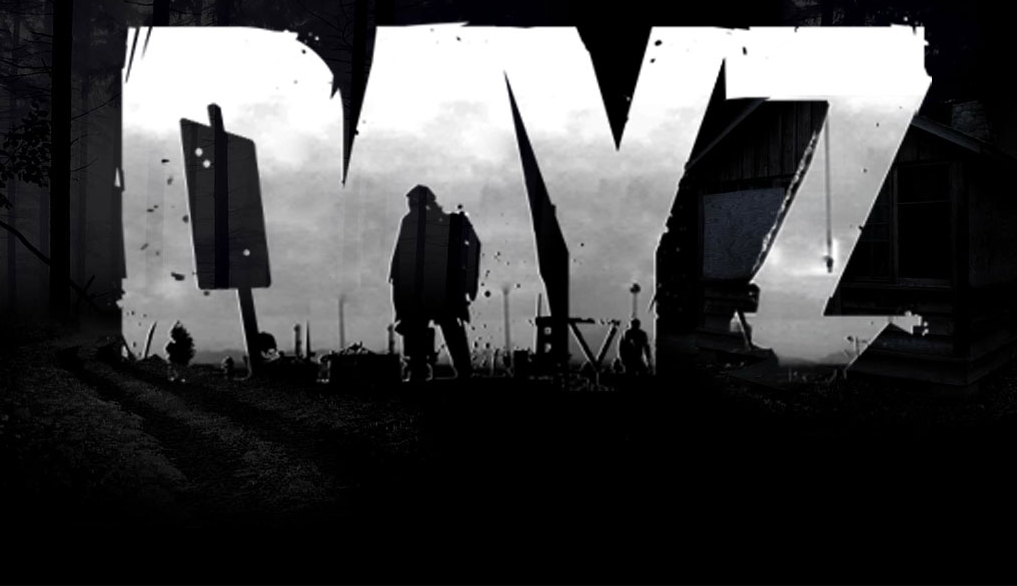
One of those talks at GDC 2013 was on DayZ (the other was about Journey). Dean Hall, the lead designer talked about creating a consistent world where things had value. The game is an FPS in a zombie apocalypse setting – so far, so generic. But the game is also permadeath, has scant supplies, and as well as zombies, has other players who may or may not be friendly. As well as avoiding zombies and bullets, you have to keep your character fed, watered and warm.
The zombie apocalypse does not itself generate tension and danger, it just provides the backdrop for this. The game boasts incredible levels of tension from the unpredictable way that other humans will act in a world without strict rules, and where killing you for ammo is just as likely as agreeing to team up. Staying alive is a painstaking process of amassing equipment from match boxes up, and all of which can be snuffed out in a moment from a sniper you never saw.
Players have been quick to share their stories on the forums. Many are the early triumphs of new players surviving more than a few minutes to gather some food and set up camp. Others are more heroic, inflicting revenge or justice on rogue players. Most make some reference to the feelings and ethical dilemmas that players experience – how a miscommunication can lead to unintended bloodbaths, or the acceptability of sniping noobs.
As with so many other Rogue-like games, it’s the danger of loss, the jeopardy, that makes the experience so rewarding. When things in the game are hard to come by and easy to lose, players place a huge amount of value on them. It’s the same reason that players love FTL or Dark Souls, where every encounter is a story and a chance to be a hero, because the risk of failure is so real and tangible. (Here is another great review on DayZ).
Empathy
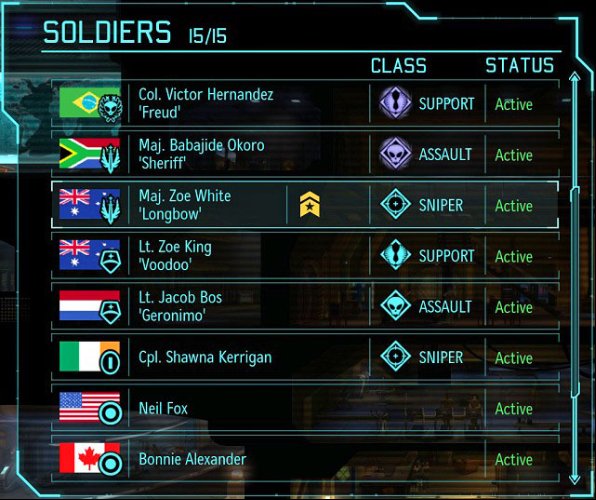
A sense of loss is also prevalent in X-Com, though to a lesser degree. Here your inevitable squad casualties from taking on alien invaders can be replaced for the next mission. However, a number of details make you feel each death of a soldier under your command more keenly. Some of this is down to the mechanics – troops gain experience and become more powerful as they survive longer, gaining unique special abilities that are crucial to your long term success. But beyond that each solider has a name, a nationality, and their own physical appearance.
These cosmetic details build on their varying stats to give a surprising amount of individuality that you empathise with, even in the absence of scripted dialogue. Pierre from France might be a craven sure to break at the first sign of danger, whilst Brad from the US is your favored sniper with a history of saving you from impossible situations. As a player you start to fill in the gaps and elaborate on their characters and backstories. If your troops survived long enough they also earn a nickname that further endears them to you, and if they die, their names are remembered in the in game memorial.
These details mean that when a soldier dies, it is not only a setback in your progression to build up an experienced team. It is a much more personal testament to your personal failure to protect your squad mates, who trusted you to command their every move. X-Com is a great example not because it is the best game at showcasing empathy for digital entities, but because it manages to achieve so much with so little.
Context : Half Life
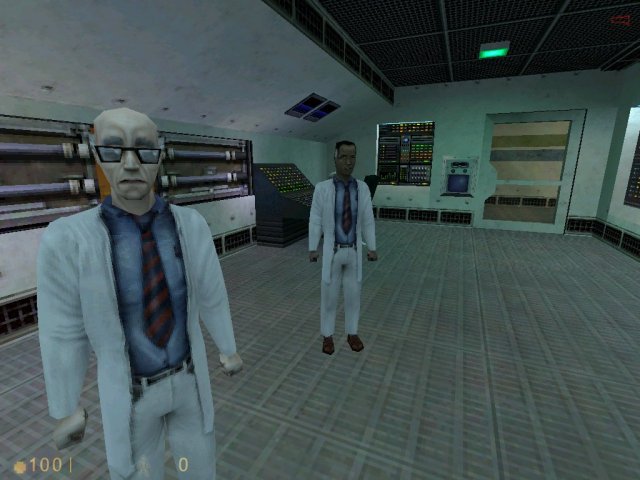
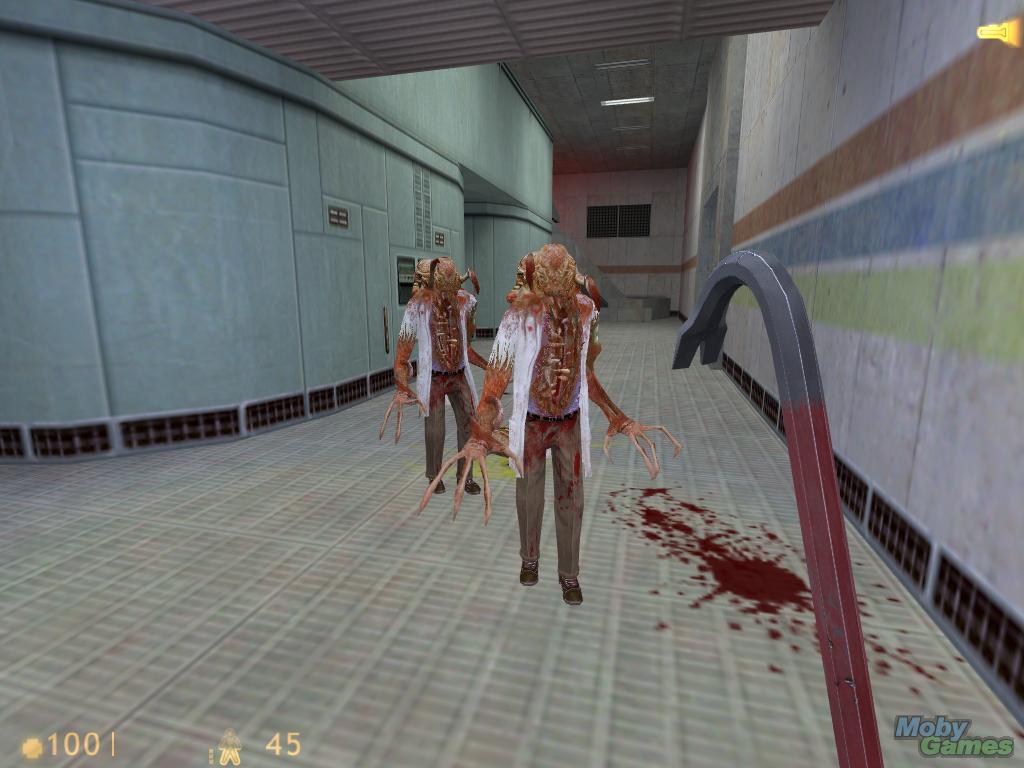
When you start Half Life, you don’t get a gun, and you don’t kill anyone. It’s an incredibly mundane start to an FPS, as you walk around a research facility going through the daily routine of the protagonist Gordon Freeman. But few games are as feted as much as Half Life for their quality of narrative. The slow start has a couple of beneficial effects on the rest of the game.
Firstly, you know that at some point, very shortly, Bad Things will happen. Just as Tarantino cranks up the tension with long, drawn out conversations that you know will eventually end in a blood bath, anticipating the upcoming excitement is every bit as good as actually experiencing it.
Secondly, once the facility is infested with aliens trying to chew your face off, there is an added gravity to the drama that you are going through. The dead bodies aren’t just decorative as in so many other games. Here they are fellow scientists you were exchanging pleasantries with a short while ago. You haven’t been born into carnage a hero, but thrust into the role of a reluctant hero as a survivor of an attack on the world you knew.
Agency : Game of Thrones
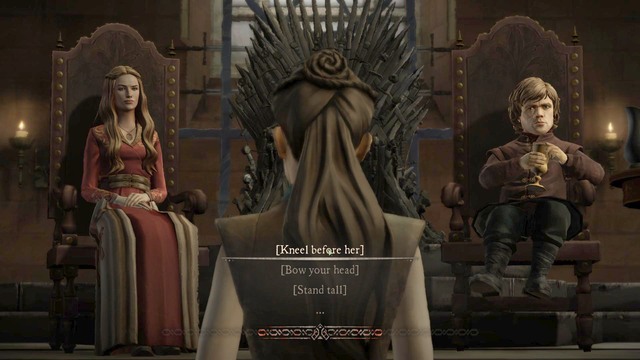
Telltale have been making games giving player big choices for 10 years. Their games are dialogue heavy, with players deciding how to respond to other characters from a range of predefined options. Their latest offering, Game of Thrones, has some exquisite moments, such as when you are interviewed by Queen Cersei. Squirming through her questioning was on a par with any similar scene from the TV series where some piteous underling is pulled apart, and I found new sympathy for the impossible situations that minor characters often find themselves in.
This scene works so well for the same reasons that many game choices of this nature fail. As an avid fan of the franchise I knew the political landscape and dangers I was traversing, and also had strong views on the type of character I wanted to play. Without this background knowledge and the sense that the choices offered would actually make a difference, my choices would have felt hollow.
In the same game there are breaks in conversation where as the player you are given the choice to say the same thing in three different ways. This adds nothing to the experience apart from slowing it down, and in reminding you that you should be identifying with one of the characters, that in actual fact you’re not.
I recently came across the other problem, of insufficient knowledge to inform a decision, in the otherwise excellent Dragon Age Inquisition. Here I had to choose between allying with one faction or another, but could explicitly not choose both. Although both factions were well known to me I felt I was still getting to grips with the world lore, and could not fully grasp the potential implications of the choice I was being given. Frustrated I resorted to the internet to understand what I was getting myself into in each case. Again, instead of deepening my immersion in the experience, poor agency had broken it.
Giving players choice to direct the story in a game is one of the defining attributes of the medium, and can be extremely powerful. However, it needs to be both a genuine choice and the player must understand the choice they are being given, or it can risk backfiring.
Conclusion
Games are often thought of solely in terms of fun. But engagement and memorability often peak when there is more than just fun, and they deliver real drama. Increasing the drama in games can be achieved by making things have value, getting players to empathise with the characters, giving the story context and allowing the player agency.
Social Gaming: Facebook, Guilds and Beyond
Facebook has had a big impact on games. Before Facebook, video games were seen as an antisocial activity for spotty boys hiding in their bedrooms. Together with the ubiquitous usage of smart phones and Nintendo’s family marketing of the Wii, the perception of both the gender bias and social nature of video games is gradually shifting.
In fact, arcade games originally followed the distribution of pinball machines in bars where adults would socialize, before spreading to family friendly venues such as cinemas and malls. Reacting to a dire recession in the early 80s Nintendo decided to focus its marketing of consoles as toys for boys, rather than entertainment for all, and in doing so set the popular view of video games for the next 30 years.
Now, finally, the industry is beginning to come full circle, and it’s the social aspect that I want to focus on here. It was on Facebook that the term “social games” was coined. Of course, games were social before, whether you were playing Mario Kart with your friends or raiding with your guild in World of Warcraft. But now, even as Facebook is steadily replaced by mobile as the new platform for gaming, everyone is still talking about social.
It’s not hard to understand why. Kongregate spoke convincingly at GDC 2013 on the importance of social features, and particularly guilds. Their talk highlighted the dramatic ways that guilds can improve retention, engagement and monetization. A few facts summarized from their presentation:
- Every one of their top 10 games has some form of guild structure
- Dawn of the Dragons (5th Planet Games): conversion rate for non guild members: 3.2% vs. guild members: 23%
- Tyrant Unleashed (Synapse Games): ARPU for non guild members: $36.59, vs. guild members: $91.60
But guilds are only one part of “social”, just as Facebook and your real life friends are. Humans are social beings, but their social interaction can take many different forms depending on the context. There is not a one-size-fits-all solution to social in games, and each game must work out what is appropriate for its own audience and mechanics (and the same is true if you are building an app). I believe that the nature of social interactions depends on whether your game is really about your Friends, the Mechanics, or the Content.
Friends
When you play a game with your real life or Facebook friends, things work best when the experience is about your friends, and not about the game. Playing with people is a great way of strengthening your relationships with them. Games are appropriate for the majority of family gatherings, whether it’s Risk or Charades.
For the experience to work out well for everyone, then the game needs to be right. The game should facilitate building relationships, and act as a backdrop to this, rather than be the main event. Games of low skill typically work best as they allow participants of all ages and abilities.
This is why games like Draw Something and QuizUp work so well, and more complicated simulation games have quickly fallen out of favour on Facebook. In the former, the experience is more about your friends, and in the latter it is more about the game. Real life friends and family are not the way to drive distribution or underpin retention unless your game is about the people you are interacting with. As we all know from the complaints about people’s newsfeeds being spammed, it isn’t that common for our friends to share our taste in games.
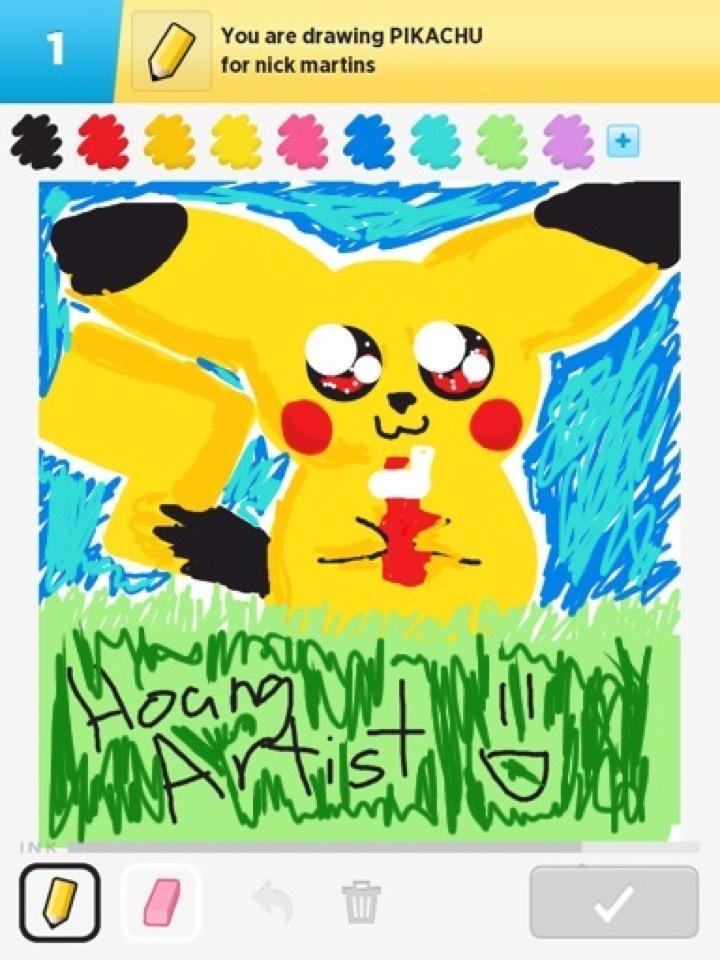
Draw Something.Chibi Pikachu by HoangArtist
Mechanics
In this category I would put everything from people who like playing otherwise family games to a competitive level, to immersive experiences such as World of Warcraft or Clash of Clans. If you are REALLY into bridge then you don’t invite your real friends over and grind them into the floor. You are going to have an unsatisfying time both in terms of the quality of gameplay, and social experience. Instead you either play a friendly match where everyone can enjoy the social aspect, or you join a bridge club and enjoy the gameplay.
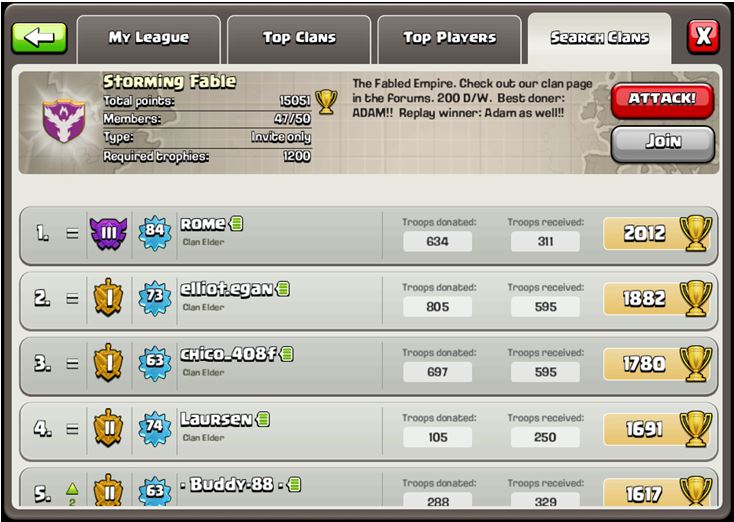
This latter case is still a social experience of course, but it’s unlikely to be one with your immediate friends and family. It’s more appropriate to share it with other people that share your love of bridge. This is exactly what Netflix and Spotify have realized as they’ve shifted their recommendations engines from showing you what your friends like, to what other people like you like. Generally we do not really care what our friends have been watching. But if we enjoyed The Godfather and The Departed, then we are interested in what other people who also liked those films would recommend.
For games that rely on their mechanics, adding in a social layer can have some powerful effects. Initially, players can even be taught how the game works by more experienced players and this knowledge flow continues as players exchange thoughts on more advanced strategies. A social aspect can enrich the gameplay by requiring the coordination of several different players such as in raids in World of Warcraft or Destiny. Finally, as these interactions build new relationships between players, they develop a sense of duty to each other, which leads them to keep coming back even if they tire of the gameplay itself.
For the social layer to add value to players, and by extension developers, it doesn’t need to involve people who are real life friends. It’s much better to group people together by the intensity that they play the game, so that they can engage at the same level as the others in their group. This is exactly what happens in Clash of Clans and many other clan based games, where the top clans demand a certain level of engagement as a requirement for membership. Not that the developers need to worry about this, as given the right tools the players organize themselves.
Content
There is however a third, much rarer way of organizing people. In games where there is a strong narrative and the experience is largely single player and driven by consuming content in a linear manner, it makes more sense to group players by their progress through this content.
This is what happens when people live-tweet TV shows. Using Twitter, viewers can feel part of a larger experience and share in the unfolding drama, regardless of whether they are actually sitting with other people watching the same show. I believe there is an innate human desire to calibrate your social responses, and this fills the same role. It helps people comprehend their own reactions, see if they are appropriate and ensure they understand the situation in full.

This is the equivalent of catching a stranger’s eye and enjoying a moment of shared understanding – we know it in a diverse set of situations from sharing the frustration of waiting in line to sharing the elation of hearing the opening beats of a favorite song at a gig. The same sort of social experience could enhance games like BioShock and Mass Effect, maximizing the impact of the most dramatic moments. However, most games that would fall into this category do not have any form of social layer, because of two problems.
Firstly, how do we bring together people who are all experiencing the content at different rates and different times? The solution here might lie in something akin to the comments sections on newspaper and magazine articles. Here the comments don’t need to be by people you know, or written whilst you read the article. But they are still relevant to you, because the person commented after they experienced the same content as you just did, and they enrich your experience of the article by providing additional information and opinions.
Secondly, how do we allow people to be social without breaking the immersion of deeply engaging games? The last thing people want after deciding who lives and who dies in The Walking Dead is for the drama of the moment to be shattered by being prompted to see what everyone else did. Luckily TellTale have the good sense to wait until the end of the episode, a natural break point before allowing you to review what everyone else did and connect you to the forums. In free to play games this might in fact be even easier, as the breaks between sessions and timers are natural point to allow people to engage with each other, both savoring recently enjoyed drama and anticipating exciting things to come.
A few games do manage to solve these problems and pull people together in this way, however. Dark Souls 2 allows other players to leave messages as you work your way through the world and narrative. These can either be helpful tips or troll postings luring you to an untimely death. You can also summon other players into your world to help out with particularly hard bosses. These interactions with other players enrich the single player experience by adding a new, social layer to it. In both cases the associations with players work because they fit into the context of your game, not because of the relationship that you have with the other players. Other players appear as phantoms and in doing so stay consistent with the Dark Souls narrative, and do not break immersion.
Wrap Up
Social rightly continues to be a buzzword in the games industry. However, there is not a single solution for what social should look like. Different types of social interactions are suited to different game experiences. When designing a game there is almost certainly some way that it can be enhanced with a social aspect, but this needs to be designed according to the type of experience that you are building for your players, rather than the design fads of the day.
This post was written by Ed Biden, who also writes at Just for the Fun of it.

























